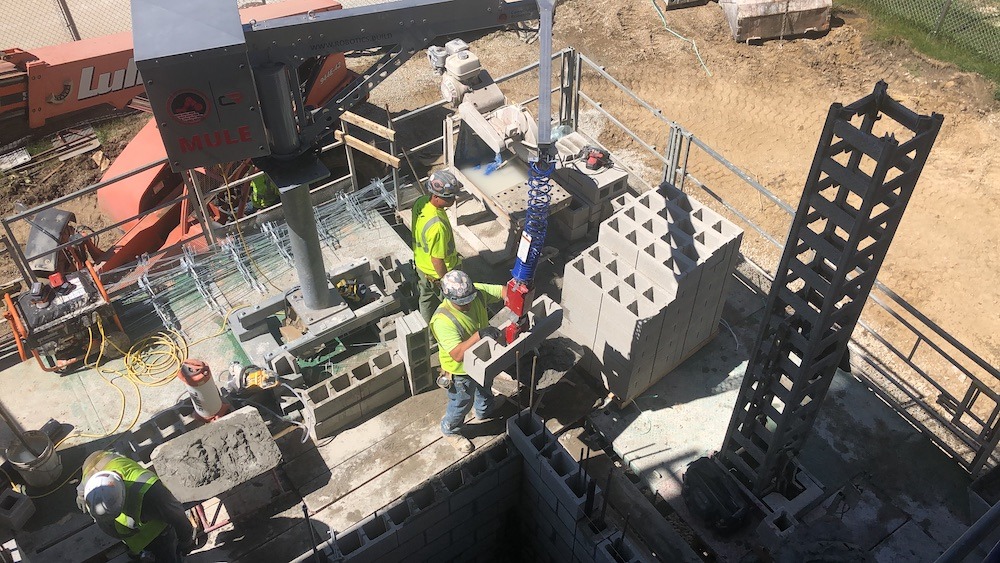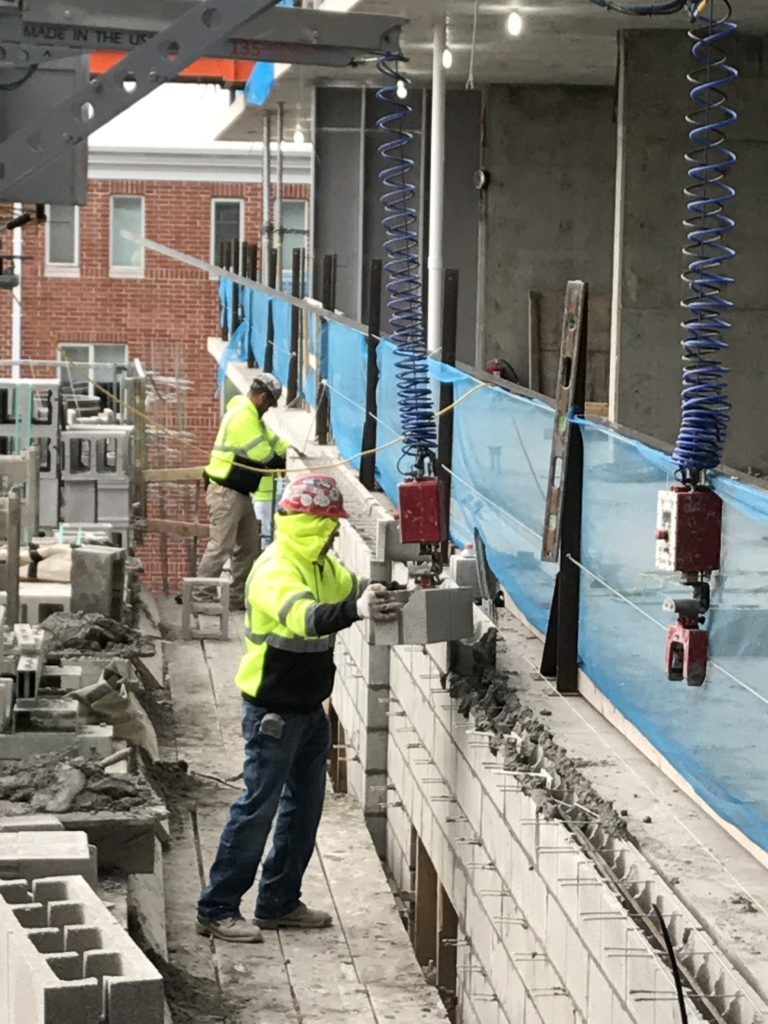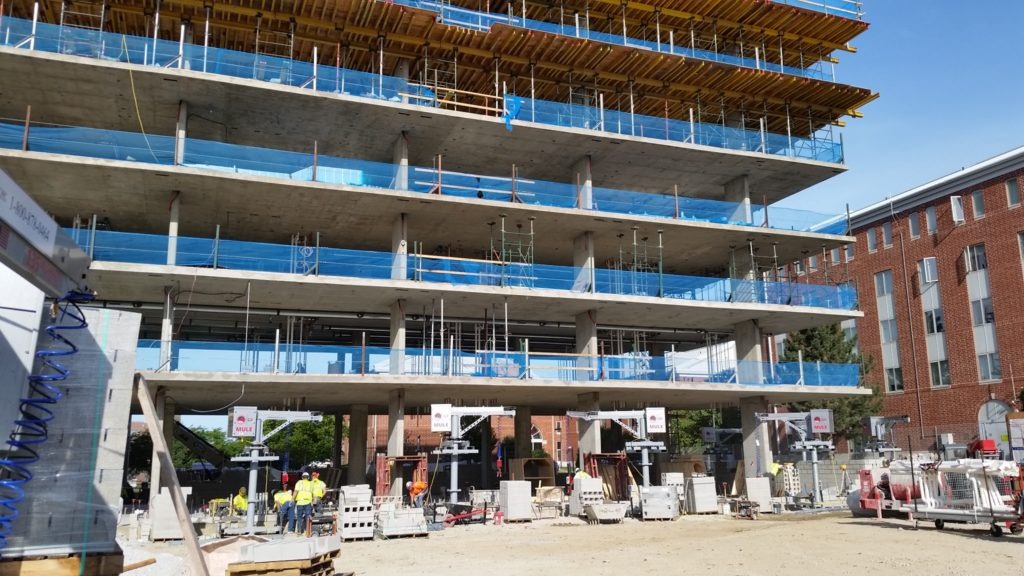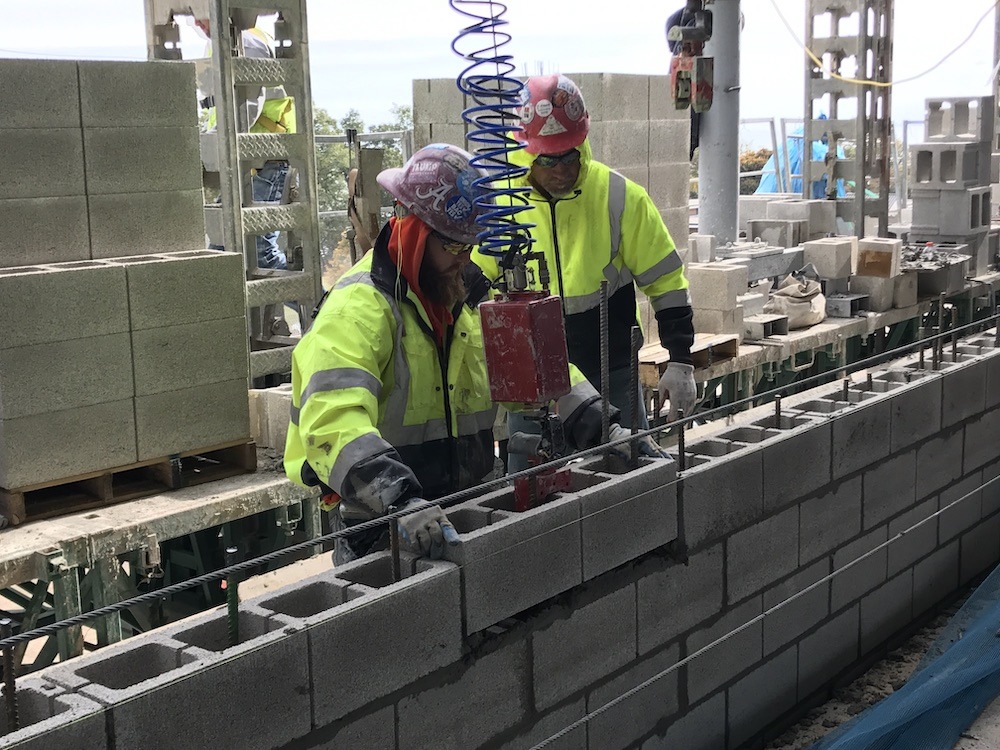Naval Station Great Lakes’ New Barracks Foundation and Facade Take Shape With Some Robotic Help
Words: Dave Jackson
Words: Dave Jackson, Senior Brand Manager, Masonry & Dry Mix at Oldcastle APG, a CRH Company
Photos: Construction Robotics
Editor’s Note: MCAA members Jimmy’Z Masonry, Oldcastle, and Construction Robotics work together to successfully construct the new barracks foundation at the Great Lakes Naval Station. Read on to discover how the MULE was used throughout the project along with all the hard work of the mason contractors and masonry products. Thank you to all three members for providing us with this interesting story.
“I always knew I would go into the business,” recalled Zack Zuidemas, Vice-President and estimator for Jimmy’Z Masonry, located in Crystal Lake, IL about 50 miles north of Chicago. Founded by his father James in the early 1990s, the company has continued to expand into one of the area’s most highly regarded masonry contractors.
While majoring in Business Management at the University of Wisconsin Eau Claire, Zack honed his skills by laboring on job sites during summer breaks and learning the project management side of the business during winter breaks. Over the years, the father/son duo have acquired a reputation for integrity, craftsmanship, and a forward-thinking approach to the masonry industry.
In 2018, the partners faced a pivotal moment for their growing business when they decided to bid for the foundation and façade components of the Naval Station Great Lakes (NSGL) new barracks project. Located about 50 miles north of Chicago, the base was in dire need of additional space to house 600 enlisted military personnel. Originally constructed in 1911, the NSGL, known as “Your Navy in the Midwest,” is the branch’s largest training installation and the home of the Navy’s only Boot Camp.
Aware of the highly competitive nature of government contracts, the Zuidemas carefully factored time, labor, and material costs into the complex bidding process. Zack reflected back on the various factors that helped them eventually win the NSGL bid including options to increase on-site efficiencies.

“We had been working with Oldcastle APG Northfield for a number of years, a reliable supplier of ours, and we had built a good relationship with them.” For such a vast foundation area—approximately 166,000 square feet— they opted to use the new oversized Supersonic™ Wall units from Oldcastle APG’s Echelon Masonry brand. The 8” x 8” x 32” dimensions of this new unit offered an opportunity to dramatically speed up installation by reducing the number of blocks to be installed.
While fewer units were needed, the 70 pounds + CMUs would require much more strength to maneuver, which could have equated to increased labor costs and extended time.
To solve this challenge, the Zuimedas took a bold leap and included in their proposal the leasing of several Material Unit Lift Enhancers (MULEs) specifically designed by Construction Robotics to facilitate the manipulation of large block-like Echelon’s Supersonic™ Wall Units.
The MULE is an electric-powered lift-assist device specifically designed to reduce the strain of masonry work. These machines – essentially miniaturized “smart” lift assist – are capable of hoisting up to 135 lbs., allowing masons to lift, move and place block with ease.
“Installing 70+ pound units manually is grueling on workers, so using the MULE created labor efficiencies while saving time and costs,” said Dave Jackson, Senior Brand Manager for Echelon Masonry.
Zack elaborated on the two-fold advantage. “We were able to plan for fewer pieces being put in the wall. And the MULEs gave us the ability to decrease labor while ensuring that our people were not getting as fatigued or strained.”
He explained the ingenuity of the design. “The gripper is on a cable suspended overhead. It clamps onto the middle of the CMU, and the block becomes weightless. The masons can then manipulate it without the strain of supporting the weight.”

Although new technology will always meet with some resistance, the contractor was pleased with how quickly most of the masons took to the user-friendly equipment. Zack recalled, “Once they stepped back and looked at the benefits, even our reluctant workers warmed up to the idea.”
He emphasized, “The use of MULEs does not change the need for the skill of the masons. It puts a lot of strain on a body to lay block that heavy all day. A lot of our veteran workers have had shoulder replacements, back problems, or injuries. This system extends career longevity for everyone.”
During the construction of the barracks foundation, the masons were able to maximize production by utilizing several scaffolds at a time. With the 22-foot MULE arm reach, the 32-inch CMUs could be pulled directly from the shipping pallet eliminating the need for messy and space-stealing pre-stocking piles. At peak production, the Zuidemas, had 12 MULEs moving block on the NSGL site.
Matt Oklevitch, Marketing Director for Construction Robotics, noted, “MULE technology assists masons by taking the added strain of balancing and positioning material out of the equation. MULE makes the block weightless in the worker’s hands and allows the mason to focus on the precision and craft of laying or installing the material.”
The teaming of Northfield’s Echelon large CMUs with CR’s MULEs resulted in reduced labor costs, time savings, and reduced physical wear and tear on workers. But the partnership did not stop there.
The barrack’s brick facade design included the overlay of another product sourced from the Echelon Masonry brand, Cordova Stone, a pre-finished anchored stone veneer that beautifully emulates natural cut stone. Zack explained, “Construction Robotics designed and created a stone veneer gripper for those 12 x 24 x 4 veneers that weighed in at approximately 90 pounds each.” This interchangeable arm could be easily swapped out with the standard gripper on the MULE, meaning Zack’s team could use the identical base for two applications.

By leasing the MULEs for the NSGL project, the Zuidemas experienced the benefits of the technology in real-time and were quickly acquainted with CR’s extensive support throughout the process. Zack explained, “The experts from Construction Robotics interacted with our workers to get feedback on how the equipment was working, and they were open to our ideas about improvements that could be made.”
The Zuidemas decided to purchase two MULES from Construction Robotics before the NSGL foundation was even fully installed. Once the leased bots were returned, they were able to complete the foundation wall and the veneer stone façade using their own equipment. With two MULEs Jimmy’Z Masonry team may have a competitive edge when bidding on other large-scale contracts.
Over the years, the building industry has undergone significant changes, most notably in the area of recruitment. According to the Chicago Tribune, “A 2016-2017 U.S. talent shortage survey, the global staffing firm Manpower Group reported that skilled-trade vacancies are the hardest jobs to fill in the country. Skilled trades (electricians, carpenters, welders, bricklayers, plasterers, plumbers, masons, and more) have maintained the No. 1 position in vacancies from 2010 to the present.”
This challenging trend has been offset by structural and technological advances in materials and equipment. According to Construction Robotics’ data, the use of the MULE can result in a six-month Return on Investment for contractors, depending on the scope of a job and material quantities utilized.

Such innovative industry advancements are sure to make the building industry more attractive to a wider demographic. Young people can look at game-changing technology like the MULE and see a career visual that is much less damaging to the body. Similarly, FRACO’s exoskeleton, a feature story from the June issue of MASONRY Magazine, is in the process of creating a suit specifically designed for the masonry industry. This suit is a hybrid system that combines passive and quasi-passive actuation to support and assist the worker in lifting and placing brick or block as well as using masonry tools.
For now, contractors hoping to win bids on major projects will continue to encounter stringent cost limitations and demanding timelines. Large stone products like Echelon’s Supersonic™ Wall Units decrease the number of units required for a job, and robotic assisters like CR’s MULE take the burden of lifting off the mason—a symbiotic process resulting in drastic reductions in labor costs.